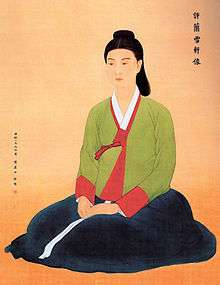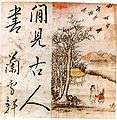Heo Nanseolheon
Heo Nanseolheon (1563–1589), born Heo Chohui, was a prominent Korean poet of the mid-Joseon dynasty. She was the younger sister of Heo Pong, a minister and political writer, and elder to Heo Gyun (1569–1618), a prominent writer of the time and credited as the author of The Tale of Hong Gildong. Her own writings consisted of some two hundred poems written in Chinese verse (hanshi), and two poems written in hangul (though her authorship of the hangul poems is contested).[1]
| Heo Nanseolheon | |
 | |
| Korean name | |
|---|---|
| Hangul | |
| Hanja | |
| Revised Romanization | Heo Chohui |
| McCune–Reischauer | Hŏ Ch'ohŭi |
| Pen name | |
| Hangul | |
| Hanja | |
| Revised Romanization | Heo Nanseolheon |
| McCune–Reischauer | Hŏ Nansŏrhŏn |
| Wikimedia Commons has media related to Heo Cho-hui. |
Biography
Early life
Heo Nanseolheon was born in Gangneung to a prominent political family (yangban). Her father, Heo Yeop, was a distinguished scholar and fathered her by his second marriage. His first was to a daughter of Prince Seop'yeong, who yielded two daughters and a son. His second marriage was to a daughter of a political minister, who mothered Nanseolheon and her two brothers. While her father was a Confucian and conservative official who subscribed tightly to the belief of namjon-yubi ("men above, women below"). It fell to her elder brother, Heo Pong, to recognize her budding talent and curiosity and introduce her to literature.
From an early age she became recognized as a prodigal poet, though due to her position as a woman she was incapable of entering into a position of distinguishment. Her early piece, "Inscriptions on the Ridge Pole of the White Jade Pavilion in the Kwanghan Palace" (Kwanghanjeon Paegongnu sangnangmun), produced at the age of eight, was lauded as a work of poetic genius and earned her the epithet "immortal maiden."[1] Her innate talent for hanmun (Chinese) verse prompted him to be her first tutor in her early years, and introduce her to Chinese writing, such as the Confucian Five Classics.
However, Heo Pong was also an outspoken and influential political scholar, and was eventually exiled to Kapsan for three years for his political leanings. Her younger brother, Heo Gyun, was a similarly gifted poet who studied under Yi Tal, a specialist of Tang poetry and a friend of Heo Pong, and he took part in her education, especially after her elder brother's exile. He fostered her education later in life, and used his preferred position as a highly respected male to keep her in correspondence with literary circles. Yi Tal, his tutor, also engaged in sharing Tang poetry with Nanseolheon, whose influence became visible in the naturalism of a significant portion of her surviving work.[2]
Marriage
Sometime during her life, she married to the son of a civil official, Kim Seongnip. Her marriage was an unhappy one, as recorded by Heo Gyun. Her husband often left her alone at home to pursue other women, and she maintained a cold relationship with her mother-in-law. She gave birth to two children, a girl and a boy, but both died in infancy in subsequent years. Within a year of her elder brother Heo Pong's death in Kapsan, she committed suicide at the age of twenty seven.[3]
The circumstances and timing of her marriage are uncertain, and documented proof is limited and subject to conjecture. Scholars such as Kim-Renaud[2] and Choe-Wall[1] engage with her literature, and hypothesize that she lived among her brothers for a significant portion of her life (during which they suggest most of her Tang-influenced and naturalistic poetry was produced), and married later. She suggests that the body of her "empathetic" poetry was produced after being married, as a result of the isolation from those who supported her literary talents and extended poetic circles. This conjecture is based on the observation that a significant portion of what is believed to be her later literature laments the plight and sufferings of married women, and her early literature follows closely in the Tang tradition, employing heavy elements of folklore and natural imagery rather than the heavier emotive language found in her later writing.
Writings
A significant amount of Nanseolheon's writing was burned upon her death per her request, and the surviving poems are collected in Heo Kyeongnan's 1913 collection Nansŏrhŏn chip. The collection consists of 211 poems, in various Chinese styles. These include koshi (traditional verse), yulshi (metered verse), cheolgu (quatrains), and a single example of kobu (rhyming prose). The writing of the early Joseon period (in the form of the political Sajang school and the more academic Sallim school) was heavily influenced by the Confucian literary tradition, and literature was primarily devoted to the expression of Confucian teachings. With the introduction of Tang poetry to Korea in the mid-Joseon Period, hanmun poetry began making significant strides as an art form. Traditional Tang poetry (koshi) was more formulaic and imposed prescriptive tonal guidelines. During the lifetime of Nanseolheon, new forms of poetry that incorporated tonal irregularities, lines with non-standard syllable counts, and length (broadly referred to as kunch'e shi, of which yulshi and cheolgu are subsets) began to come into favor. Nanseolheon's works are noted primarily for their broad range of subject matter, which is attributed in part to the drastic emotional shift evoked by her marriage.[1]
The inclusion of two kasa written in hangul in the collection is one of scholarly contention, as her authorship is in doubt. Composition in hangul was considered unworthy of expressing higher thinking of Confucian ideals, and "literary" composition in Korea was almost entirely composed in hanmun. The distinction at the time was similar to the differences between Latin composition and vernacular prose in Renaissance Europe. Her authorship of these two pieces is supported mainly by the observation that the titles of the two kasa pieces, "Song of Woman's Complaint" and "Song of Coloring Nails with Touch-me-not Balsam" are very similar to two verified hanmun (cheolgu and koshi respectively). These claims have in part discredited by recent scholarship by O Haein (Nansorhon shijip) and Kang Cheongseop (Moktongga ui pogwon e taehayo).
Sample poems
The poem, "Song of Autumn Night" is characteristic of her earlier, more fantastical and imagery-rich poetry. It is a seven-syllable cheolgu.
秋夜曲 |
"Song of Autumn Night" |
| —Heo Nanseolheon[4] | —Translated by Kuiwon[4] |
"The Young Seamstress," or "Song for the Poor Girl", is one of her poems of empathy, where she sympathizes with those from poorer economic backgrounds. It is a five-syllable cheolgu.[1]
貧女吟 |
"The Young Seamstress" |
| —Heo Nanseolheon | —Translated by David R. McCann[5] |
"Woman's Grievance," another seven-syllable cheolgu, exemplifies the tone of the poetry believed to have been written after her marriage.[1]
閨怨 |
"Woman's Grievance" |
| —Heo Nanseolheon[1] | —Translated by Yang-hi Cheo-Wall[1] |
Gallery
 Anggan bigeumdo, painted by Heo Nanseolheon
Anggan bigeumdo, painted by Heo Nanseolheon Mukjodo
Mukjodo Nanseolheon jip
Nanseolheon jip Her poetry book Chwesawonchang (1612)
Her poetry book Chwesawonchang (1612) The house of her birth
The house of her birth
Works
- Nanseolheon jip
- Chwesawonchang
References
- Choe-Wall, Yang-hi. Vision of a Phoenix: the Poems of Hŏ Nansŏrhŏn. Ithaca, NY: East Asia Program, Cornell University, 2003. Print.
- Kim-Renaud, Young-Key. Creative Women of Korea: the Fifteenth through the Twentieth Centuries. Armonk, NY: M.E. Sharpe, 2004. Print.
- "Heo Gyun and Heo Nanseolheon". PR Korea Times. September 29, 2005. Archived from the original on June 10, 2011. Retrieved October 6, 2008.
- kuiwon.wordpress Archived 2011-10-16 at the Wayback Machine
- McCann, David R. Early Korean Literature: Selections and Introductions. New York: Columbia UP, 2000. Print.
Bibliography
- Choe-Wall, Yang-hi. Vision of a Phoenix: the Poems of Hŏ Nansŏrhŏn.
- Kim, Jaihiun Joyce. Classical Korean Poetry.
- Kim-Renaud, Young-Key. Creative Women of Korea: the Fifteenth through the Twentieth Centuries.
- Lee, Peter H. Anthology of Korean Literature: from Early times to the Nineteenth Century.
- Lee, Peter H. The Columbia Anthology of Traditional Korean Poetry.
- McCann, David R. Early Korean Literature: Selections and Introductions.
- McCann, David R. Form and Freedom in Korean Poetry.
External links
- Heo Chohui (in English)
- Memorial to the Heo Brothers and Sister (in Korean)